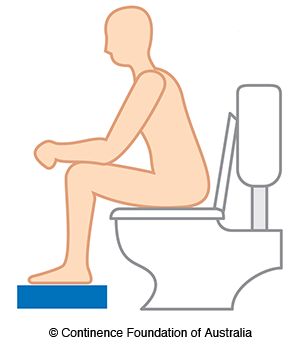DIET
Drink enough fluids
- Drink enough fluids to quench your thirst. Speak to your doctor about how much fluid intake is right for you
- spread your drinks evenly throughout the day
- drink more fluids (preferably water) if the weather is hot or if you are exercising
- cut down on alcohol, fizzy drinks and caffeinated drinks as they can irritate the bladder.
Tip: Don't reduce your fluid intake if you have a bladder control problem. This will concentrate your urine and make the problem worse.
Eat well
- Eat plenty of fibre which improves bowel function by absorbing water and adding bulk to your bowel motions (poo). Bulky stools keep things moving through your bowel to avoid constipation. Fibre is found in foods such as multigrain or whole grain breads, cereals/cereal products, fruit, vegetables, legumes, nuts and seeds.
- Eat two servings of fruit, five servings of vegetables and five servings of cereals/breads each day.
Tip: A high fibre diet means you need to drink plenty of fluid as the fibre needs water in order to bulk up your bowel motions (poo).
LIFESTYLE
Lead a healthy lifestyle
- Maintain an healthy body weight with a Body Mass Index (BMI) of 25 or less. Excess body fat strains the pelvic floor and can lead to bladder and bowel control problems.
Tip: Speak to your family doctor or a qualified dietitian for more information about safe ways to lose weight.
- Stop smoking. An ongoing cough associated with smoking can weaken the muscles of your pelvic floor and lead to bladder and bowel control problems.
Tip: Talk to your family doctor or pharmacist about quitting smoking and managing an ongoing cough. You can also contact the Quitline on 131 848 to get information or advice about a smoking cessation plan.
Get active
- Aim to exercise for 30 minutes most days. Exercise stimulates movement of the bowel and even gentle exercise like walking helps.
- Do your pelvic floor muscle exercises regularly. Pregnancy, childbirth, regular heavy lifting and a chronic cough can weaken the pelvic floor, but you can strengthen these muscles with specific exercises.
TOILET HABITS
Practice good toilet habits
- Go to the toilet when you get the urge to open your bowels. Most people get the urge first thing in the morning or following a meal when eating has stimulated the bowel.
 Get into the correct sitting position on the toilet. Sit on the toilet, elbows on knees, lean forward and (if required) support feet with a footstool. This helps to fully relax your pelvic floor and sphincter muscles. Bulge out your abdomen (tummy), relax your anus (back passage) and let go. Don’t hold your breath or strain. When you have finished firmly draw up your back passage.
Get into the correct sitting position on the toilet. Sit on the toilet, elbows on knees, lean forward and (if required) support feet with a footstool. This helps to fully relax your pelvic floor and sphincter muscles. Bulge out your abdomen (tummy), relax your anus (back passage) and let go. Don’t hold your breath or strain. When you have finished firmly draw up your back passage.- Avoid constipation as this affects bladder and bowel function. If you often strain to move your bowels, the pelvic floor stretches and weakens over time.
- Don't get into the habit of going to the toilet 'just in case' – only go when you need to.
- Visit your doctor as soon as you suspect a urinary tract infection.
THE 5 HEALTHY HABITS
Continence Health Australia encourages Australians to invest time in 5 healthy habits to help prevent incontinence. These habits include a healthy diet and staying hydrated, 30 minutes of exercise every day and good toilet habits.
SEEK HELP
Seek help for bladder and bowel problems, as the symptoms will not go away on their own and may worsen over time. Talk to your family doctor or contact the National Continence Helpline on 1800 33 00 66.
The National Continence Helpline is staffed by Nurse Continence Specialists who offer free and confidential information, advice and support. They also provide a wide range of continence-related resources and referrals to local services.

